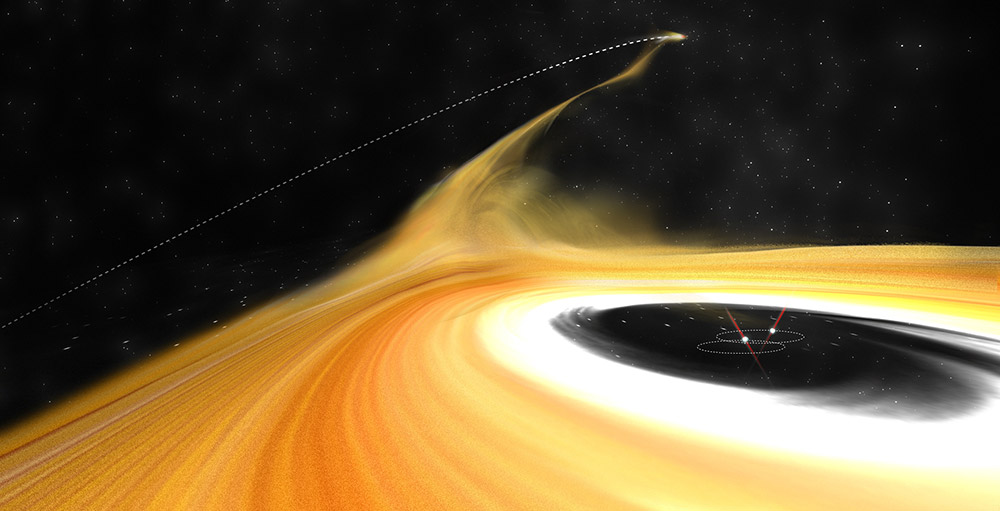The action took place: Astronomers observed a rare cosmic event – a star flyby of a young planetary system. The passing star caused a visible disturbance in the dust disk of Z Canis Majoris, leaving long filaments of gas and dust behind. This event is exciting, among other things, because the Solar System may have experienced such stellar passages.
Stars are rarely born singly, and they usually form in dense clusters of many young stars. As a result, close encounters between them can happen quite frequently, especially in the early days. Such stellar orbits create gravitational disturbances, which can strongly affect the evolution of a young star and especially its planets. According to current theory, such a stellar corridor in the solar system could, among other things, comets orbits, and perhaps even exoplanets.
mysterious branch
But until now, astronomers have rarely been able to observe such stellar passages. But a team led by Rubing Dong of Victoria University in Canada has now picked up a red-handed star. It was observed when astronomers examined the binary star system Z Canis Majoris, which is about 3750 light-years away, using the Atacama Large Millimeter/submillimeter Array (ALMA) and Very Large Array (VA) radio telescopes.
This star system in the constellation Canis Major, which is about a million years old, is still surrounded by a large protoplanetary disk of gas and dust. A clear, long filament-shaped extension stems from this disc to the southwest. “The origin of this impulse has always been a mystery,” the astronomers explain. It is thought to be caused by molecular outflow, a helical arm caused by gravitational instability, or the remnants of a trapped gas cloud, depending on the hypothesis.”
The point of light reveals the possible “culprit”
However, new observations with ALMA and VLA revealed a previously overlooked element: About 4,700 astronomical units of the binary star, the researchers detected a tiny point of light that lies precisely in the stretch of the mysterious spur. “The newly discovered C light source points to another scenario we consider to be the most likely: C could be a young stellar object that recently made a close pass of Z Canis Majoris,” the team said.
This flyby of the young star could explain how the long streak of gas and dust formed: the passage of the interstellar body caused a gravitational disturbance that removed some material from the planetary disk of the young binary star. “The impulse is thus a structure that arose through these interactions,” Dong and colleagues explain.
Run past at a 45-degree angle
According to additional simulations, the stellar body should have rushed into the star system and its dust disk at a 45-degree angle and on a parabolic trajectory. The team explains that the young star was moving forward — in the same direction as the turntable, because the retrograde lane results in much weaker effects. Then the pass occurred at a distance of about 3,000 AU from the center of the system – thus a good 2,000 AU from the edge of the dust disk.
However, the effects of gravity were enough to tear two spiral protuberances from the star system. The astronomers explain: “These arms are located at different levels, and therefore they are illuminated at different levels.” This is why only the arm that is more towards us can be considered an extension in telescopic images. At the same time, the star’s corridor also explains why the young double star shows an especially large number of bursts of radiation – this can also be caused by gravitational disturbance.
If we look at the past in our solar system
“Our discovery shows that close encounters between young stars occur not only in simulations, but also in reality,” Dong says. “While previous observations have seen potential fly-bys, they haven’t seen as many details and evidence as we did with Z Canis Majoris.” Such events have an impact on the evolution of potential planets in turbulent systems.
“Studying these types of events also gives us a window into the past, including developments that may have occurred in the early days of our solar system,” Dong says. While their traces have long since disappeared, possible events in other star systems can now be understood. “We can then say: Ah! This is what happened a long time ago in our solar system.” (Natural Astronomy, 2022; doi: 10.1038/s41550-021-01558-y)
Quelle: National Radio Astronomy Observatory

“Total coffee aficionado. Travel buff. Music ninja. Bacon nerd. Beeraholic.”







More Stories
Researchers detect extremely high-energy gamma rays
Anxiety disorders in old age increase the risk of dementia
Researchers are particularly fascinated by these exoplanets.